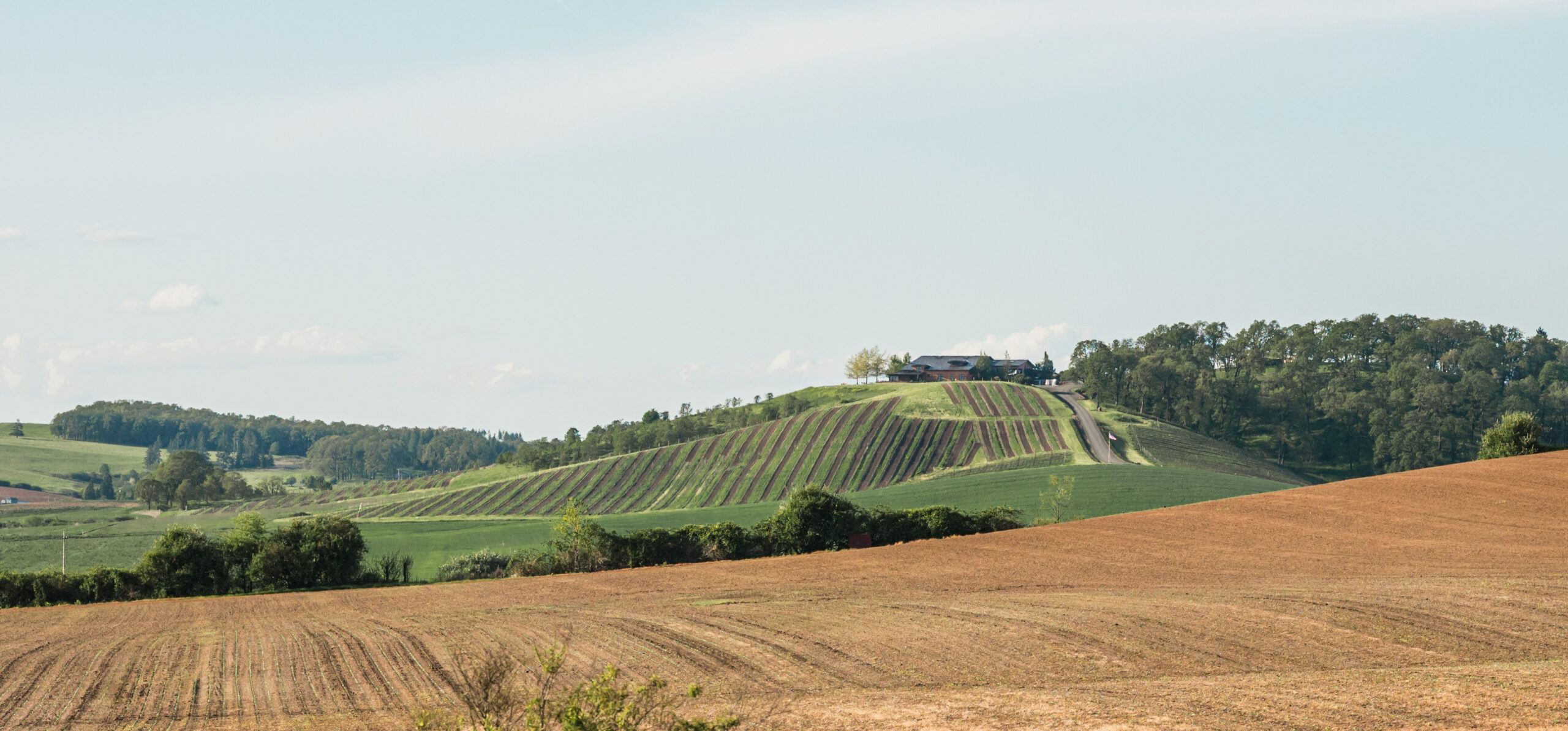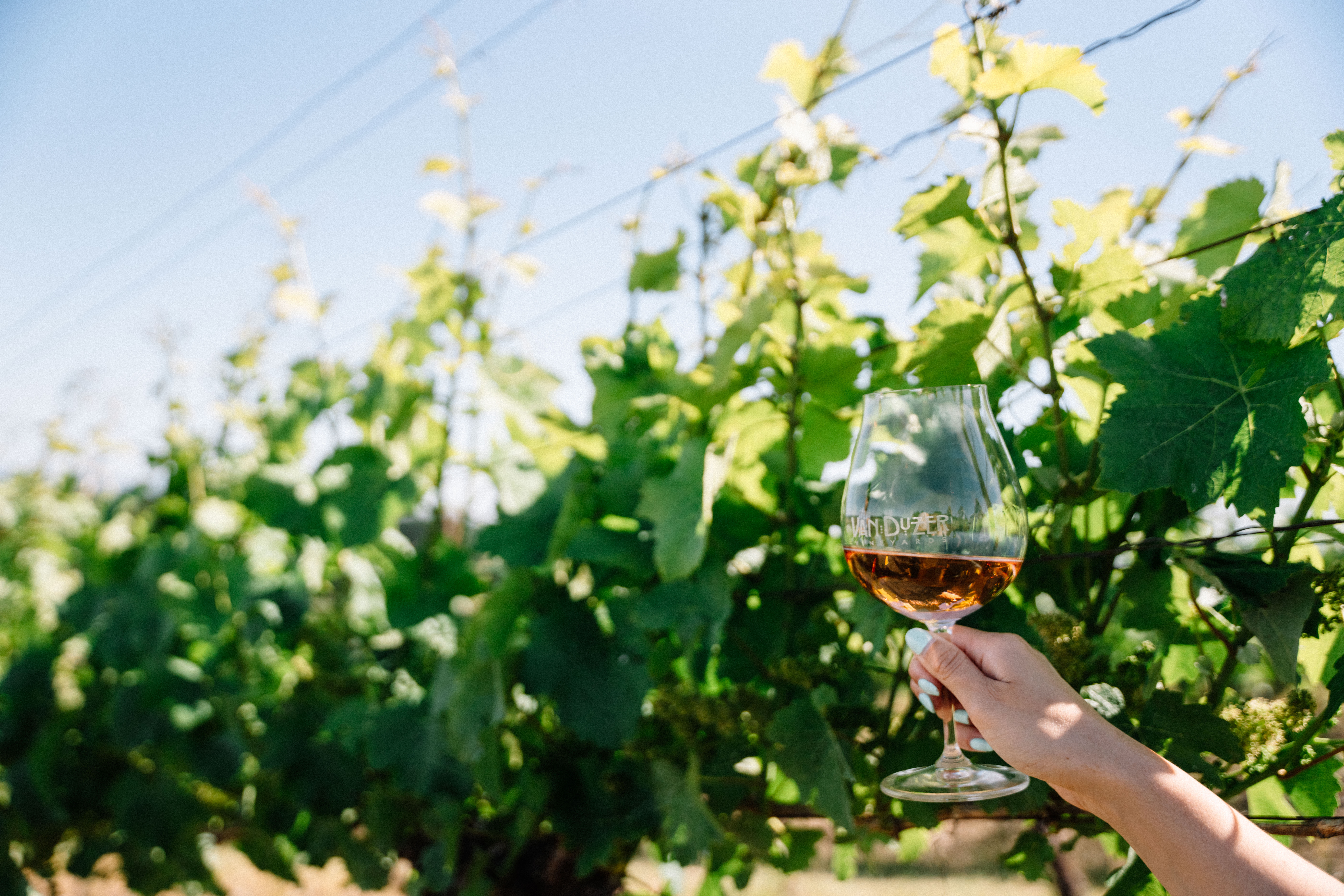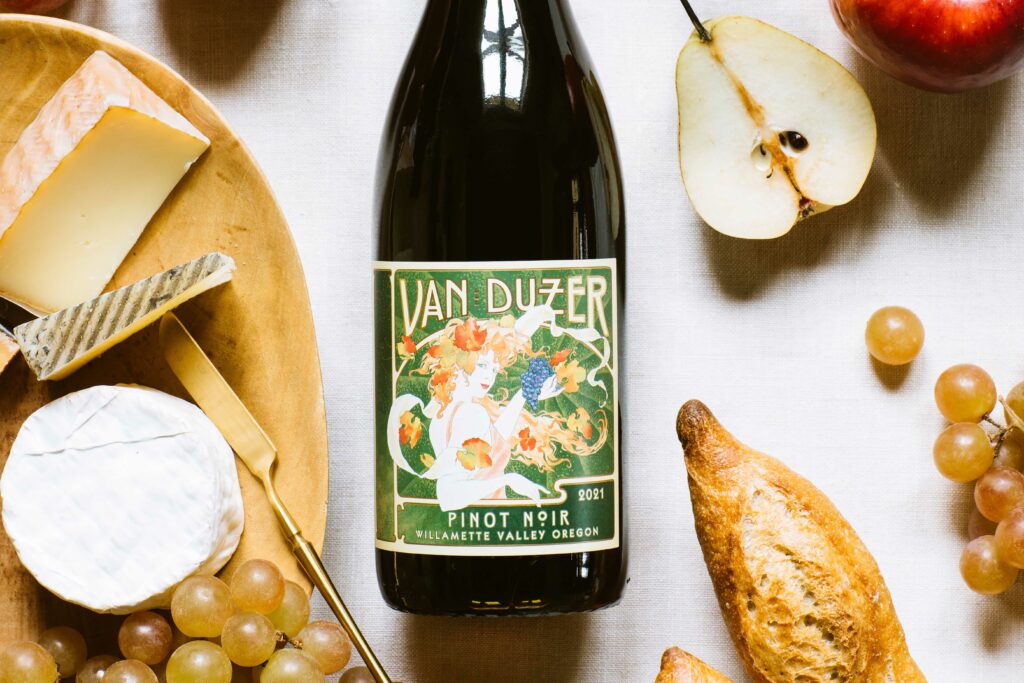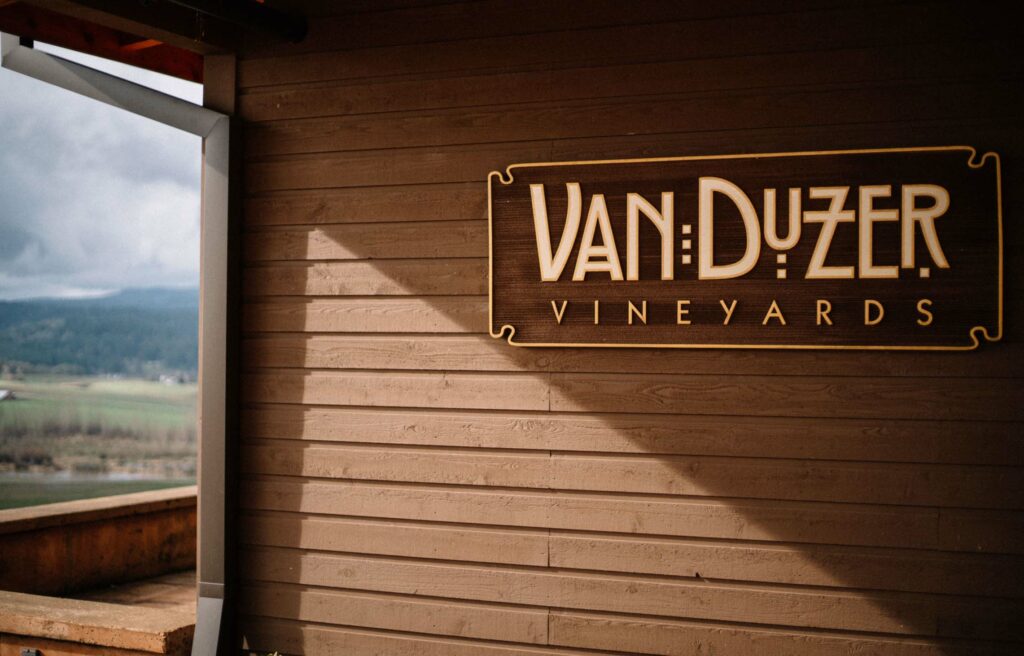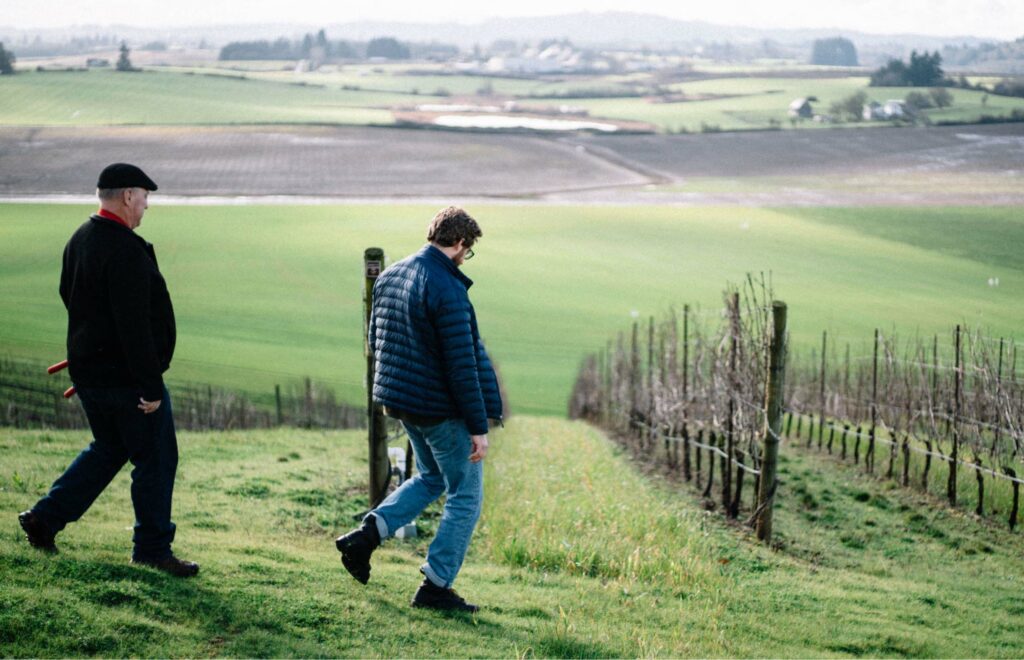Exploring soil types in the Willamette Valley
In the heart of Oregon’s Willamette Valley, two distinct American Viticultural Areas (AVAs) stand out for their unique soil compositions and the influence they have on the wines. The Van Duzer Corridor AVA, characterized by marine sediment soil, and the Dundee Hills AVA, known for its volcanic soils. These two distinct soil types create very different wines. Here at Van Duzer Vineyards, we’re lucky to work with grapes from these two AVAs. Our namesake Van Duzer Vineyard here in the corridor and our Thoma Estate Vineyard in the Dundee Hills AVA which we purchased and began planting in 2015.
Soil types develop geologically through a complex process involving the weathering of parent rocks, the influence of climate, topography, vegetation cover, and time. The formation of soil begins with the breakdown of rocks into smaller particles through physical, chemical, and biological weathering processes. Over time, these broken-down rock particles mix with organic matter from decaying plant and animal material, creating the foundation for soil development. Magic, right?
Also, as weathering continues, minerals leach from the soil profile and move downward, leading to the formation of distinct layers or horizons. Different soil types, such as sandy, clay, or loamy soils, emerge. In addition, the geological history of an area, including its tectonic activity, sedimentation processes, and past climatic changes, shape the characteristics of soil types found in the region and, in turn, the wines that a region produces.
How did the different soil types develop in the Willamette Valley?
Here in the Willamette Valley in Oregon we have a fascinating geological history that has led to the development of soil types in the region, particularly in its renowned wine-producing areas. The valley’s soil composition is the result of ancient volcanic activity, glacial deposits, and sedimentation processes that have occurred over millions of years.
The dominant soil series in the Willamette Valley include Jory, Willakenzie, and Nekia, each with distinct characteristics such as high fertility, excellent drainage, and the presence of volcanic ash deposits. These diverse soil types not only contribute to the region’s terroir but also play a crucial role in shaping the flavors and aromas of the wines produced in the Willamette Valley. For example, Jory soil is known for its red color and ability to retain water and is ideal for cultivating Pinot Noir grapes, the flagship varietal of our region.
Van Duzer Corridor AVA: The Ocean Effect
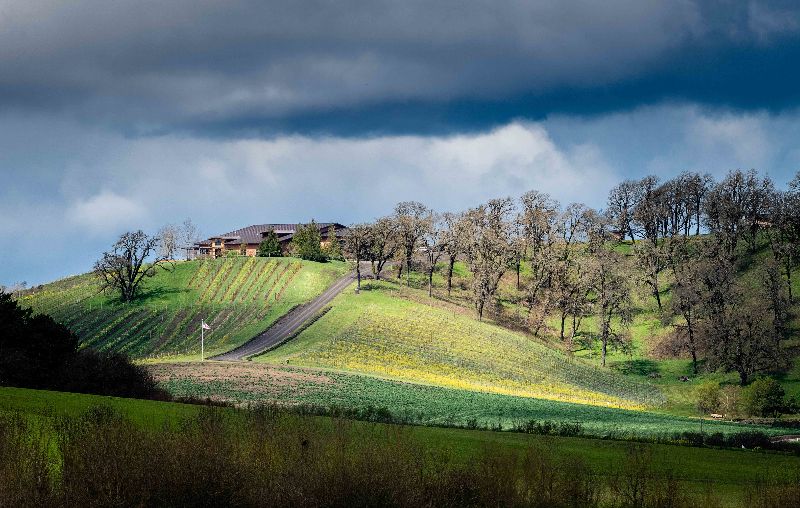
Nestled within the expansive Willamette Valley, the Van Duzer Corridor AVA’s terroir is dominated by marine sedimentary soils. The soil composition of our namesake AVA is rich in silt, clay, and sand, with deposits of fossilized marine organisms which lends a unique complexity to the terroir.
Our Van Duzer Estate Vineyard, which we purchased and began farming in 1999, lies in the heart of the Van Duzer Corridor. In summer, temperate breezes chase the afternoon heat, wrapping our 82 acres of grape vines in cool Pacific air that slows the growing process, extends hang time, and builds intensity of flavor through harvest. Recorded temperature lows at Van Duzer Vineyards average 13 degrees cooler than those experienced in the northern Willamette Valley. However, the corridor’s microclimate buffers the effect of cold, as well, keeping the area slightly warmer in years where the temperature is lower than average.
Our Vineyard Manager, Bruce Sonnen, explains “the soil was formed through the flooding process of the Missoula floods deposits and marine uplift. Our soils are extraordinarily rich, nutrient heavy, extremely complex; sometimes vine to vine.” He goes on to explain; “for me as a vineyards manager, knowing the differences in the soil and where those transitions happen is critical for farming balanced vines. Seventy percent of the vineyard was planted on virgin soil before detailed soil mapping was performed.”
“At that time,” Bruce explains, “vines were planted in long rows, sometimes covering three to five different soil types. We now can see the differences in the vines and the way they grow and adjust according to cultivation and/or cover crop management to balance out the vines. New plantings over the past 15 years have had detailed mapping done and vines with rootstock are planted according to soil type, not necessarily ease of farming.”
The marine influence in the Van Duzer Corridor AVA goes beyond soil composition, as cooling breezes from the nearby Pacific Ocean play a crucial role in shaping the region’s climate. These maritime winds help moderate temperatures, leading to a longer growing season that allows grapes to ripen gradually, retaining essential acidity and developing nuanced flavors.
Our winemaker, Eric Misiewicz, reflects on these soils; “At Van Duzer typically the soil goes from being wet to dry very quickly. When we irrigate, we walk a knife’s edge to maintain the balance between concentration and vigor” he says. “The wind in the corridor impacts the fruit in creating more tannin, and if the soil is dry this contributes to fruit dehydration this can lead to overly intense tannin. We have to be incredibly careful in the vineyard and cellar to get the balance right.”
Dundee Hills AVA: The Red Earth All Around
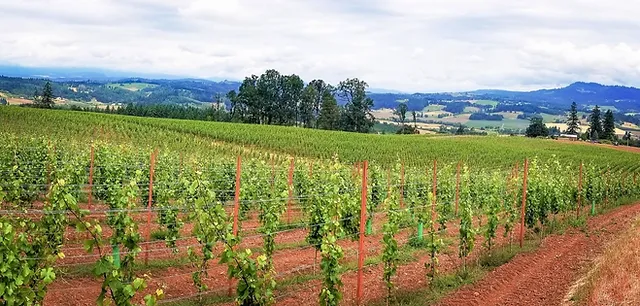
In contrast to the marine sediment soil of the Van Duzer Corridor AVA, the Dundee Hills AVA highlights the volcanic origins of its terroir through its signature red Jory soil which is rich in volcanic basalt. Volcanic soils are renowned for their fertility and moisture-retaining capabilities, creating an ideal environment for vine roots to delve deep into the earth and extract essential nutrients. The volcanic ash deposits in the Dundee Hills AVA infuse the soil with a myriad of minerals, enriching the grapes with distinct characteristics that are translated into the wines produced in this region. The warm microclimate of the Dundee Hills, coupled with the heat-retaining properties of volcanic soils, provides an optimal setting for ripening Pinot Noir grapes, the hallmark varietal of the Willamette Valley.
Our Thoma Estate Vineyard lies atop the rich red volcanic soils of the Willamette Valley’s Dundee Hills AVA. As our Vineyard Manager, Bruce explains; “our Thoma Estate vineyard was purchased in 2015. So, all the latest technology at the time was used for the prepping of the vineyard prior to planting – and detailed soil maps and nutrient balance sheets were performed.” He goes on to say, “As the vineyard was planted, breaks in the vineyard blocks occurred on the soil transition lines and we discovered that soils are 75% Volcanic and 25% Marine – so on the same Dundee Hills site we get the effects of both soil series. This allows for more complex wines through blending or distinct block wines through location on property.”
Whereas the Van Duzer Estate Vineyard is defined by wind, the Thoma Estate Vineyard is characterized by the soil’s high iron content, which lends earthy, meaty qualities to the wines grown here. Although it’s primarily volcanic, there are pockets of marine sediment soils at this vineyard.
Our winemaker, Eric, describes these different soil types at our Thoma Estate Vineyard in more depth: “Thoma has three distinct winemaking profiles that come from the soil, the volcanic western ridge, mid elevation volcanic, and sloping marine sediment” he explains. “The western ridge typically makes the most tightly wound and red fruited wines from the property. At the same time, the mid elevation volcanics produce a wine that is deeply perfumed and rounder in structure often requiring a little help with whole cluster. Finally, the marine sediment slope makes a wine more similar in style to Yamhill-Carlton with dark blue fruit and lower acidities.”
Impacts on Wine Production: Soil types in the Willamette Valley
The differences in soil composition between the Van Duzer Corridor and Dundee Hills AVAs are reflected in the wines that emerge from these regions. Wines from the Van Duzer Corridor AVA exhibit a pronounced minerality and salinity, a direct result of the marine sediment soil that underpins the vineyards. These wines are characterized by bright acidity, fresh fruit notes, and a sense of elegance that speaks to the cool climate influence.
On the other hand, wines from the Dundee Hills AVA display a deep richness and complexity derived from the volcanic soils that nurture the grapevines. The red Jory soil imparts a distinctive earthy character to the wines, complementing the ripe fruit flavors and silky tannins that are synonymous with the terroir of this AVA. These distinct soil types in the Willamette Valley create distinct wines.
When working with grapes from the Van Duzer Corridor, we focus on preserving the natural acidity of the grapes, utilizing minimal intervention techniques to allow the terroir’s unique characteristics to shine through. The resulting wines are marked by their vibrant acidity, elegance, and a clear expression of the marine soil.
Conversely, when working with fruit from our Dundee Hills estate, we focus on harnessing the power of volcanic soils to create wines that exude structure and balance. The wines from the Dundee Hills AVA are celebrated for their elegance, finesse, and a distinct sense of place that speaks to the volcanic origins of the soil.

